
Hello, and welcome to today’s presentation, in which I’ll talk about the latest digital marketing trends that all small businesses should be paying attention to. I’ll discuss why these trends are important to small businesses and what they can do to start jumping on the trend and taking advantage of it to help them grow their business.
My name is Danna Crawford and I’m also known as Power Selling Mom – quick info about me … I’m an authorized local expert with Constant Contact. I’ve been using their service since 2006 and shortly after that I became a Certified business consultant, trained by eBay after being an active seller on the site since 1997 – With my experience of teaching eBay classes and workshops in partnership with the United States Postal Service, Constant Contact contacted me to go through their certification program and now I do webinars and local workshops on the topic of social media and email marketing – Next I became the Development Director for our local Foodbank (FirstStepFoodbank.org) after a meeting with the board while I was teaching them about fundraising using Constant Contact and eBay, next thing you know they offered me a part time job that I couldn’t resist since I’m passionate about the Cause of feeding America – So those are the three hats I wear, Constant Contact, eBay and the Food bank! You can learn more about me by visiting my website at PowerSellingMom.com or just google my name. (Danna Crawford)
Let me take just a minute to explain what Constant Contact is for those who may not be familiar.
Constant Contact is a do-it-yourself online marketing system. You can use it to be a marketer for your own small business or organization. The company is best known for its email marketing tools. It’s easy to create and send mass email, like newsletters or announcements and updates. You can run special promotions or offers; you can build online surveys and polls to gather feedback; and you can promote and manage your events using Constant Contact with registration tools, payment acceptance and invitations – all in one place.
You can use all the tools and tips we’ll discuss today in your own small business or nonprofit marketing. You can be a marketer. All it takes is Constant Contact.
Digital marketing is the application of technology – devices, platforms, channels and practices – to connect to audiences. They could be audiences of your current customers or members, or prospects you hope to bring into your business.
I’m not going to assume that “everyone is doing it”…but I am going to tell you that when it comes to digital marketing, everyone should be. If you’ve got your direct mail or print or other traditional marketing efforts nailed down, that’s great – digital marketing will be a fantastic complement to those efforts.
But at the end of the day technology is changing the behavior of consumers, and digital marketing is the answer for small businesses trying to reach those consumers where they are.
What is digital marketing
According to Wikipedia: Digital marketing is that makes use of electronic devices (computers) such as personal computers, smartphones, cellphones, tablets and game consoles to engage with stakeholders. Digital marketing applies technologies or platforms such as websites, e-mail, apps (classic and mobile) and social networks. Digital Marketing can be through Non-internet channels like TV, Radio, SMS, etc. or through Internet channels like Social Media, E-mails ads, Banner ads, etc.. Social Media Marketing is a component of digital marketing. Many organizations use a combination of traditional and digital marketing channels; however, digital marketing is becoming more popular with marketers as it allows them to track their Return on Investment (ROI) more accurately compared to other traditional marketing channels.
What digital tools has already done for small businesses is well known. The access to platforms and channels has allowed small businesses to take more control than ever over their own marketing and their reach to the audiences needed to drive their business.
They have also allowed small businesses to efficiently manage their marketing efforts in ways that won’t break the bank. Take Hope Hummus for example. They’re a hummus manufacturer in Colorado and they sell through distributors like grocery stores and markets. They’re easily able to manage their brand through their website and email communications.
They make excellent use of social media, posting inspiring videos that share their brand personality as well as recipes for how to enjoy their products. They’ve considered the mobile experience in the design of their communications. And above all else, they’ve recognized that while their business flows through distributors, they have to create the connection to the person who’s buying their product…and they’ve even gone so far as to make it easy through their website (on a desktop or mobile device) to “find Hope.”
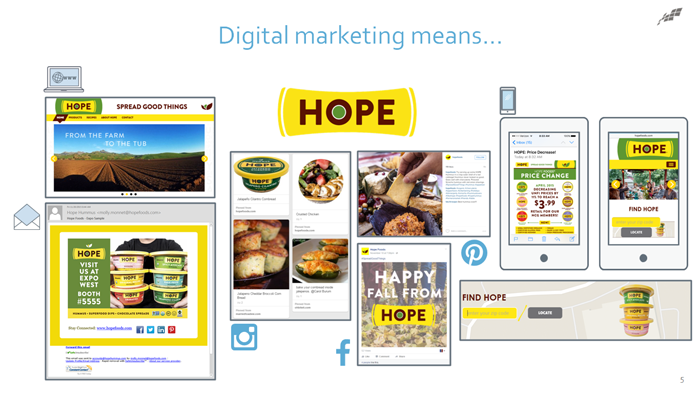
Look at all of the ways in which they’ve taken advantage of what digital marketing has to offer them!! What you see here is also a great reflection of the trends we’re going to talk about today.
Ok, you may be asking…if I need to be getting set up on digital marketing channels and platforms, how do I know which one to use? It can be really hard to determine what the right channel or mix of channels could be.
First, I can tell you that you don’t have to use all of them. Ok? So you can relax a little bit.
And fortunately, there are some quick questions you can ask yourself to help figure out if you’re ready to jump onto this digital marketing adventure:
– Time – how much time can you devote to the tactic or channel, like a social network? You may not need to hire a new staff member to manage your use of Facebook, but can you devote enough time to make it worthwhile?
– Resources – or maybe you do need someone else in your business to focus on the new tactic or channel you’re considering. Do you have that resource, or can you add it?
– Will you or your team know how to get the most out of that channel? If the answer to this is “no,” you’re going to need to find training or someone who does have the skill.
– Finally…do you know where your audience is spending their time?
I encourage to keep these questions in mind as we go through each trend to determine which trend is most accessible to you. You can even use these questions to help you rank the trends in order of which ones you can do right away, in a few weeks/months, or maybe not at all.
Hottest Digital Marketing trends of 2017
– Marketing Automation
– Content Marketing
– Video Marketing
– Mobile Marketing
– Big Data
Marketing automation
describes the ability to automate repetitive tasks like email, social media, and other website actions. The intention is to nurture prospects with highly personalized, useful content in order to convert prospects to customers and build customer loyalty.
By learning about your audience, you can segment them into categories/demographics/interests and create customized content that speaks to them (instead of creating universal content, sending to your entire list, and hoping someone reads it).
Why is this a smart idea, you ask? [Or, “why is this a worthy trend?”]
Source:https://contentmarketinginstitute.com/2016/08/content-marketing-trends/
Think about the world through your customers’ eyes – there are more ways for messages to be communicated than ever before.
In addition to all the digital marketing they receive, don’t forget marketing messages in magazines, on television, in the direct mail they receive. Sometimes this can be overwhelming…for both the receivers of those messages and those (like you) trying to figure out through which channels to deliver messages.
Combine all of those channels and consider the number of marketing impressions we generally get in a day…one study found that 264 was an average per person, per day! They estimated as conservatively as they could, so the actual number may be higher. If every channel and every message was given a voice, a person would feel like they’re standing in a full auditorium where everyone was shouting for their attention.
What’s the result?
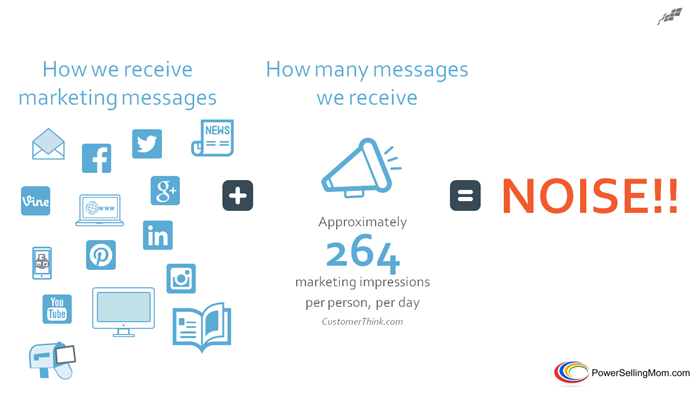
It’s just so much noise.
- Approximately 264 impressions per person per day (CustomerThink.com, 2015 https://customerthink.com/how-many-ads-per-day-do-you-see-fewer-than-it-seems-i-think/)
Therefore, anything that helps cut through the noise will incredibly valuable to both consumer and business.
- 40% of consumers will buy more from a business that seeks to personalize their experience, and
- Over half are more likely to shop when the experience is more personalized.
Now…in case you’ve ever felt a bit awkward when asking for information from customers, or you wanted to avoid annoying them by asking for their information, consider this:
3 out of 4 consumers are willing to share their information if they believe they’ll have a better experience. So what are you waiting for?
Sources
First two data points came from this post (with reference to the original source): https://www.resourceforsolutions.com/how-personalization-has-already-become-the-future-of-marketing/
76% Source: https://impress1.com/connect/blog/entry/top-3-digital-marketing-trends-for-2016-which-you-should-be-starting-in-2015.html
Last one comes from: https://www.brandanew.co/wp-content/uploads/2015/09/7-Digital-Marketing-Trends-For-Your-Brand-Success-in-2016-Brandanew.jpg
A critical component of marketing automation is targeting and segmenting. These are marketing terms that reflect what makes your customers, clients or volunteers unique…and then creating marketing touch points that reflect their uniqueness.
It’s dividing people into groups based on information like interests and demographics. You might already be segmenting by categorizing or grouping your contacts. It’s important because some promotions are not one-size-fits-all!
Marketing automation can apply to everything from your website, to your contact management, to your email marketing. Let’s take email marketing as the example…does it seem more effective to send out ONE email message to everyone on your list and hope a percentage of those people like it?
Or to send a couple different emails slightly tweaked for each segment, knowing that the majority will like it? I’m guessing the second option…and that you realize that “hope” is not a strategy.
Email is one of the most accessible channels to automate your marketing. Targeting and segmenting to create personalize automated messages does not have to be difficult. Let me show you what I mean…

Take these 2 automated welcome emails from the Loveland Youth Gardeners non-profit. (shown above) These emails are almost exactly the same, except a small tweak to match the given audience. One is targeted to people who have donated or sponsored the organization. The other is targeted to those you have registered to volunteer.
You can take your targeting to any level on the spectrum, if you want to make it even more personalized than this. The point is, you can hop on the automation trend without going overboard. Some is better than none.
Email is an easy place to start. It’s more important than ever for our digital marketing strategies. But the trend is moving from “just email” into “marketing automation”. Activities such as contact management, list segmentation, lead nurturing, and reporting can all be done more efficiently through automation.
Source: https://contentmarketinginstitute.com/2016/08/content-marketing-trends/
Don’t know enough about your audience to segment? Go ahead and ask them! Sending surveys are a great way to hear it straight from the horse’s mouth. There are also services (like TowerData) that will help you scan your list and pull available information about your audience.
Here’s just a short list of the kinds of information you can start collecting for individual consumers or members…[click to build]
- Demographics
- Interests
- Buying/giving behavior
- Frequency of purchase/donation
- Timing of purchase/donation
- Categories of purchase
- Specific causes/events donated to
- Events attended
- Communication behavior
- Social media – channels used
- Content preferences – text, images, video
- Frequency desired – daily, weekly, monthly
- Device Usage – phone, tablet, laptop, desktop
At the end of the day, you’re going to want as much information as you can comfortably collect….
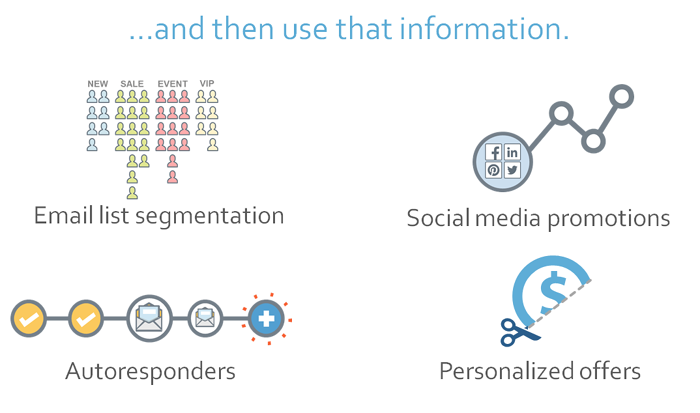
…to help you with your overall marketing efforts. Here are just a few of the things that that information will help you with:
–Segment your lists. The information you have is what will help you target your content and efforts…and you also use that information to break down (or segment) your contact lists. You can segment those lists around just about any criteria you want, although larger buckets are a good place to start. Buying habits, donation frequency, specific interests related to your business…start with the easy ones.
In most databases now the actual act of identifying the segment or segments that someone belongs to is called “tagging” – you apply tags to the individuals, so that later the database can quickly provide just a smaller list from the whole, based on that segment.
– Autoresponders is a general name for any kind of automated marketing delivery effort you may have. It can involve the automatic sending of emails at certain time intervals to whatever audience is specified. You can use the information you’ve collected to develop targeted content and deliver it to those individuals who select (and are then tagged with) certain criteria. These are a great way to provide a consistent experience to segments of your customer base, and to save you time in doing so.
– Social media promotions and discount offers: these are just two promotional ideas that can be carried out based on your list segmentation. You can develop special promotions or offers that will appeal to different subsets of your customer or prospect base.
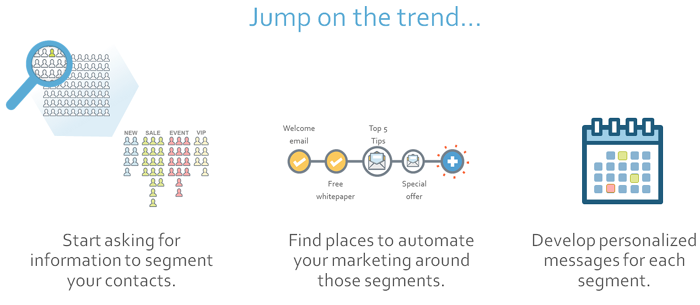
The topic of targeting, segmentation and personalization, like all of the trends we’re discussing today, could fill its own presentation. But you’ve now seen enough of why it’s important, what to start collection and what to do with the information to get started.
To quickly recap, here are some things you cold start doing today…
– Review your contacts list. Do you know enough about your customers or members and their interests and tendencies to start tagging and segmenting your large list into smaller lists? If not, start asking questions (a simple survey is a great place to start) to get that information, and then start segmenting.
– Find places in your marketing efforts where you could automate your efforts with that segmentation in mind. I mentioned autoresponders before…they’re a great place to start.
– Finally, think about creating some special events or offers for different segments of your audiences.

Not far from the idea of marketing automation and sending content that speaks to your audience, is the idea of content marketing. You may have heard the phrase “content is king”. As much as 88% of marketing will be done through content between 2016 and 2017. This trend has been continuously growing over the years due to the increase of “noise” we talked about earlier, in addition to the growing trend of purchasing from businesses based on trust. Source: https://www.business2community.com/digital-marketing/will-important-digital-marketing-trends-2016-2017-01616860#l2Y2Xlhs3MDruuf9.97
Here is the definition of content marketing.
The most important pieces here state that you need to provide valuable, relevant and consistent content that ultimately drives profitable customer action. If you’re a nonprofit, you could substitute positive member contribution.
Content is what allows you to connect with your audience. It helps you provide extra value, build relationships, and demonstrate expertise, which are cornerstones to the modern-day sales funnel. It’s no longer considered “novel” for an organization to have a blog, or to send beautiful emails about deals and sales…it’s the norm.
It’s not just about how things look, although that’s important. Content marketing is more important than ever when you look at these two statistics.
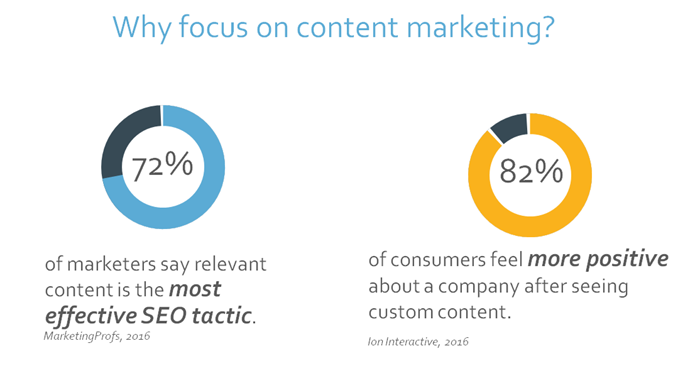
– 72% of marketers worldwide say relevant content is the most effective SEO tactic. (https://www.webpresencesolutions.net/150-digital-marketing-seo-statistics-2016/)
Search engines comb the internet for keywords to determine search relevance (which means they’re looking at your website for content). But search engine algorithms will change in 2017, as they always do. With the enormous amount of information being added to the internet every second, search engine giants will keep on updating their algorithm to decide which content should get priority and rank higher in search engine result pages. The only strategy should be to remain original, informative, and helpful to your audience by creating great content.
https://www.shoutmeloud.com/2017-digital-marketing-trends.html
– 82% of consumers feel more positive about a company after seeing custom content (https://apps.ioninteractive.com/site/iig/75stats)
Content marketing is all about building trust with your customers. Trust and authenticity are two things that people are always looking for when choosing who to believe and follow. While this is often difficult to achieve without face-to-face communication, intimate social media platforms such as Snapchat and Periscope give content marketers the ability to humanize their brand and get closer to their audience.
https://www.hashmeta.com/blog/2017-content-marketing-trends-every-marketeer-needs-know/
Traditional content is published on a blog, which absolutely has its place in content marketing. But the new trend in content publishing is social media.
The first thing to note about some social media platforms is that they predominantly attract younger users (the majority of Snapchat users are under 34), so it only makes sense to use them if your target audience lies within this user demographic. If they do, then think about how you can leverage the intimate nature of these platforms to offer your true fans content that will deepen your relationship with them. Some examples to get you going include AMAs (Ask Me Anything), behind the scenes snippets, employee introductions, quick tips, as well as coupons and giveaways.
The key is to discern which of these options are worth investing time and energy into. How you decide will depend on answering the questions that you should already be asking. Source:
https://www.hashmeta.com/blog/2017-content-marketing-trends-every-marketeer-needs-know/
– Who is my target audience?
– What do they care about?
– What media platform/s can we really excel at?
These are the questions you should answer before trying to publish every kind of content on every kind of platform. This is a game of working smarter, not harder.
Let’s start with your target audience. If you’re going to create content that resonates, you need a clear picture of who you’re trying to reach. Any decisions you make for your strategy stem from having a deep understanding of this audience.
Let me give you an example of what I mean here. Let’s say you needed to explain quantum physics to your Mom, your wife or husband, or a child. You can see how your approach is going to be a bit or even vastly different for each of these people.
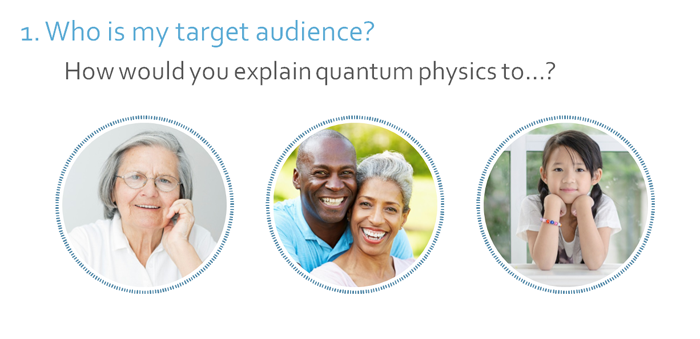
Their level of knowledge is different, their point of reference is different, and the way they process information is likely different as well. Now, I’ll admit this is a somewhat silly example, but it makes the point.
The bottom line is this: If you don’t know who you’re trying to communicate with, it’s impossible to know what kind of content they want. And this really is step one. Everything builds from who it is you’re trying to reach.
You can use tools like Google Analytics, Facebook Insights, and even surveys to begin understanding your audience, if you don’t already have a clear picture of demographics. You can also pool these resources to start considering what platforms will be most effective depending on who your target audience is and where they spend their time.
So again for any of this to really work toward business goals you need to know who it is you’re trying to reach because that’s going to help you determine what kind of content to create.
Make sense?
Source: https://coschedule.com/blog/how-to-find-your-target-audience
Once you know who it is you’re trying to reach, the next step is to uncover the pain points for this audience. [click to build] A key thing to keep in mind is that most people are unclear as to what the solutions to their problems are, but they are very aware of the problems themselves.
Let’s say, for example, you offer SEO services. It’s probable that a potential customer may not even know that they need SEO services. They’re not focused on the solution. But they are well aware of the problems they’re having. What they do know is that when they Google the things their customers may be looking for, their business in not on the first page and no one is finding their website.
Uncover what they want to know, what they need to know, their like and dislikes, and their wants and desires.
Also keep in mind that understanding challenges for your customers and potential customers also shows up throughout each step of the buying cycle and are often more related to things that make us people, than they are related to your product or service.
You must know what your audience cares about most. This way you can understand how to best gain their attention and help them. In doing so, you become a trusted resource and when they’re ready to buy, you’ll be the person they choose.
– Note from from Dave Charest, Senior Manager of Content and Social Media Marketing at Constant Contact
“Earlier this year my wife and I bought our first house. When we were looking for the right lender to work with regarding our loan, we put feelers out to a few recommendations. Now my particular worry in this situation, was that I wanted someone to walk me through the process and not feel like I was getting screwed.
And honestly, I was surprised by how some of them chose to respond back.
One group hunted down my work phone number and called me there when the message I left contained my personal info. Another was not very caring on the phone and seemed to push me toward filling out a form rather than answering my questions. Finally, we found someone who was extremely helpful, sent follow-up information, and even made personalized video to walk me through the different lending options available to me. This person also would check in with new info I might find useful from time to time during the process. His actions and manner helped overcome the agony I was concerned with during this process. Needless to say, that’s the lender we went with.”
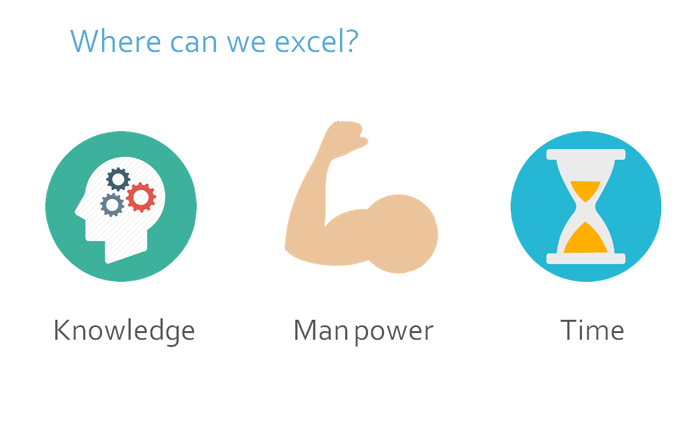
One of the more important pieces of your content strategy from a business standpoint is understanding your opportunities and your limitations. In addition to getting to know your audience and where they play online, as well as developing a sense for what kind of content they are hungry for, you need to determine where you want to focus your energy to promote your content. Of course, part of knowing your audience means understanding where they spend their time. (It might also be smart to do a little research on your competitors to see where they are most active). But before you jump into a new platform (or multiple) based on that information alone, consider your organization’s ability to excel in each environment.
Think about things like:
– Your experience and knowledge with the tool. If you’ve never logged into Snapchat, you probably don’t want to build an entire content strategy around that platform, at least until you’ve had a chance to familiarize yourself. You don’t have to be an expert, but you do need to be realistic about what you will and will not keep up with in the long term.
– The man power it takes to keep it up and running. Part of your content marketing strategy will be the length of your posts and at what quality? For example, an e-book on LinkedIn would require more forethought than a 3 minutes stream at a networking event on Facebook Live.
– The amount of time you would need to dedicate to it. Some platforms are more fast-paced than others and require frequent posts, so this is something to consider when thinking about where to post your content and how to build your content marketing strategy.
Now that you understand who your audience is, what kinds of information they would care about, and where you want to promote your content, you might be wondering “what are my options for types of content anyway?”. Here are a few examples of different types of content formats based on positive ratings with consumers.
Although blog posts are still very highly esteemed in the online community, there are plenty of other formats to consider. If you’re promoting content on social media, be aware that content marketing is changing form. Longer posts seem to be on the rise in 2017, so don’t be afraid to use social media and other digital platforms to share lengthier content.
source: https://www.smartinsights.com/content-management/managing-content-marketing/competing-content-marketing-infographic/
source: https://www.business2community.com/digital-marketing/will-important-digital-marketing-trends-2016-2017-01616860#xPQPRS3HmYUk13r7.99
Here’s what you can do today to get started:
First, you need to figure out where your customers, members or audience is today – what social media channels do they use most often? Do they prefer to communicate via email or get their information in some other way? When are they open to receiving marketing messages? And here’s the most important piece…if you’re not sure, you have to ask them!
Now look at where you are today?
– Are you where your audience is?
– Are you trying to do too much?
– Do you need to do more?
– Finally, choose one of the channels you’re not using that your audience is, and start working to make that a part of your marketing mix. Start small, let your audience know that you’re going to be dipping your toe into that water, and build from there.
As you think about your content marketing strategy, consider adding video in 2017. Video is a top trend this year. This comes as no surprise with internet speeds and mobile usage continually rising to enable users to stream videos wherever they are, whenever they want. Smart marketers will latch onto this trend by creating relevant, high quality video content by leveraging on video-friendly social media networks such as YouTube, Facebook and Instagram.
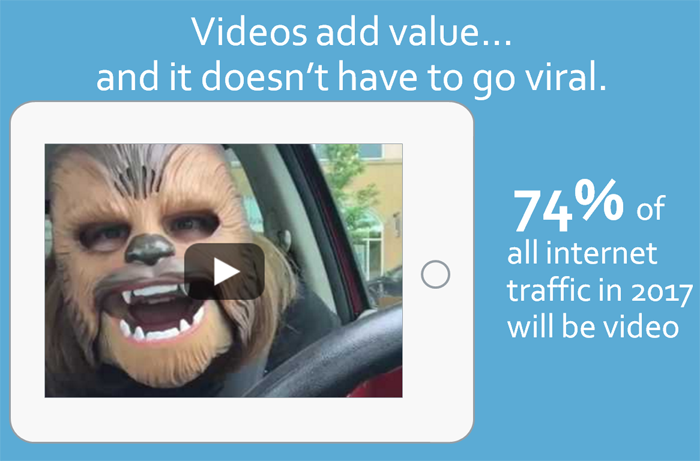
It doesn’t take “Chewbacca Mom” to show us how big and important using video and having a visual storytelling strategy are. But, it’s a mistake to focus your video strategy solely on viral video. You should be building a process for the ongoing creation of valuable videos specifically for your target audience.
As a small business (and not a deliriously comical mom), you can leverage the benefits of video as a part of your long-term content marketing strategy, and not just a one-time slam dunk. After all, 74 percent of all Internet traffic in 2017 will be video, which means it doesn’t have to be viral to be valuable.
source: https://contentmarketinginstitute.com/2016/08/content-marketing-trends/
74%.. (source: https://www.business2community.com/digital-marketing/will-important-digital-marketing-trends-2016-2017-01616860#xPQPRS3HmYUk13r7.99
Keep in mind that production quality aside, the effectiveness of videos is very much platform-specific.
For example, evergreen video content works well on YouTube due to how users search and discover videos,
shareable and time-sensitive videos work well on Facebook and Twitter due to the social nature of consuming content,
(twitter says that videos and photos get the most retweets)
while short-form attention-grabbing videos are more suited to platforms like Instagram and Snapchat.
Remember to consider where YOUR target audience spends most of their time, and consider creating videos that match that platform (rather than creating multiple types of videos and trying to cover every platform). There are 2 platforms in particular that are trending in 2016 and 2017.
https://www.hashmeta.com/blog/2017-content-marketing-trends-every-marketeer-needs-know/
Twitter…most retweets…https://www.business2community.com/digital-marketing/will-important-digital-marketing-trends-2016-2017-01616860#xPQPRS3HmYUk13r7.99
Heard of Facebook Live?

If you’ve updated your Facebook app lately, you may have noticed Facebook has reorganized its appearance to draw more attention to the ability to “go live”, as well as a specific notification just for videos.
Although Facebook is not the largest video streaming platform, it does have the largest number of active users. For this reason, it’s a great option for small businesses to increase their visibility. It’s especially suited for small business because of the ability to create and share videos the don’t require excess scripting or editing, so it can be done fairly quickly and cheaply. Plus, it is accompanied by an app notification when a live stream is happening to grab your audience’s attention with minimal additional effort.
- Facebook Live is very easy-to-use and businesses of all types can use live streaming to increase engagement with their Facebook followers. To get started on Facebook Live, simply click on the Live button in your News Feed, write a short description of what your audience is going to see and start filming. https://mediakix.com/2016/08/facebook-trends-disrupting-social-media/#gs.RSA7D=s
With over 100 million daily active users and 400 million snaps per day, Snapchat is one of the fastest-growing social networks. As you might already assume, 71% of Snapchat’s U.S. users fall into the 18 to 34 age range.
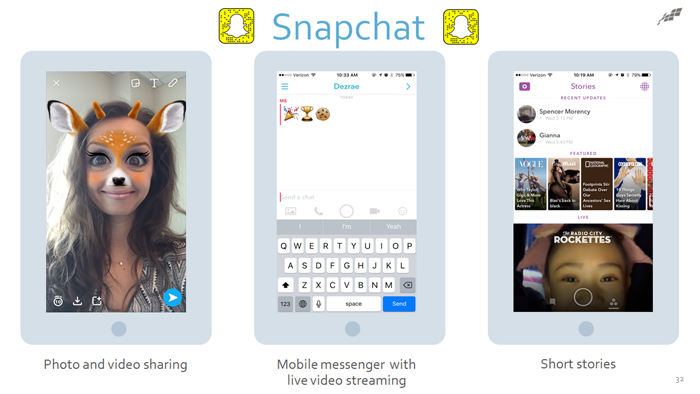
It has a variety of features, including 10 second photo and video sharing, short stories that are viewable for 24 hours, a mobile messenger with live video streaming (similar to apple’s facetime), and more.
So how can you use snapchat for your business? Here are 3 ideas:
Provide Access to Live Events
Offer Contests, Perks or Promotions
Take People Behind the Curtain
Authenticity is a visual trend in 2017, so anything that can help you humanize your brand to your audience is a definite bonus.
https://www.socialmediaexaminer.com/5-ways-to-use-snapchat-for-business/
https://stories.gettyimages.com/getty-images-2017-visual-trends/
What can you do today? Here are a few things:
– Can you include a video in your email? Make your own or give credit to someone else’s.
– What video platform does your audience spend the most time on? Determine which will have the biggest impact, then make videos that match.
– Develop a strategy based on your platform. Should your videos be short? Long? Time-sensitive? How frequently should you share?
Mobile Marketing
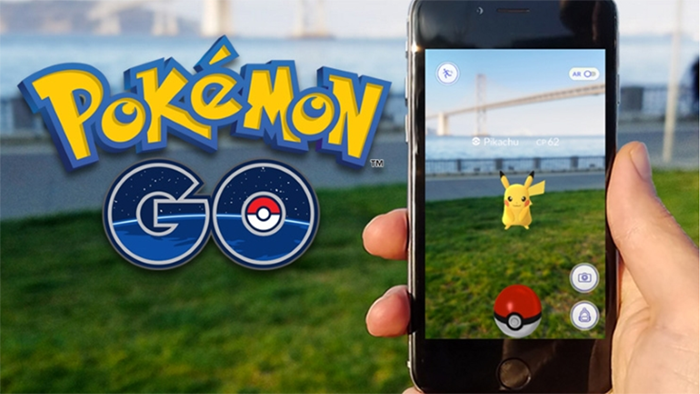
If Pokémon Go didn’t prove how quickly trends can spread on mobile, I’m not sure what will. The insanely high rate of adoption helped Pokémon Go earn as much as $14 million within 6 days of being released. Thanks to widespread ownership of smartphones, as well as ever-increasing data networks, combined with a cultural desire for mobile engagement, mobile marketing is a trend to seriously consider in 2017.
https://www.theverge.com/2016/7/22/12258874/pokemon-go-apple-ios-app-store-record-most-downloads
There is lots of data around us that points to the increasing role that mobile devices play in our lives, and the lives of our prospects, customers, members or clients. Over 80% of people on the internet own a smartphone. Not only do we like owning our phones, we are VERY attached to them. Many of us won’t even leave it to visit the bathroom. Which is great for business owners because 4 out of 5 of those people are using their smartphone to shop.
Many retailers are recognizing this trend and incentivizing the use of mobile phones with discounts and coupons targeted at mobile users. Many restaurants are doing the same thing by offering a free drink, appetizer or a coupon code to those that check in on Yelp or Facebook.

Source:
80%+…https://www.hashmeta.com/blog/2017-content-marketing-trends-every-marketeer-needs-know/’
75% + 4 out of 5… https://www.business2community.com/digital-marketing/will-important-digital-marketing-trends-2016-2017-01616860#xPQPRS3HmYUk13r7.99
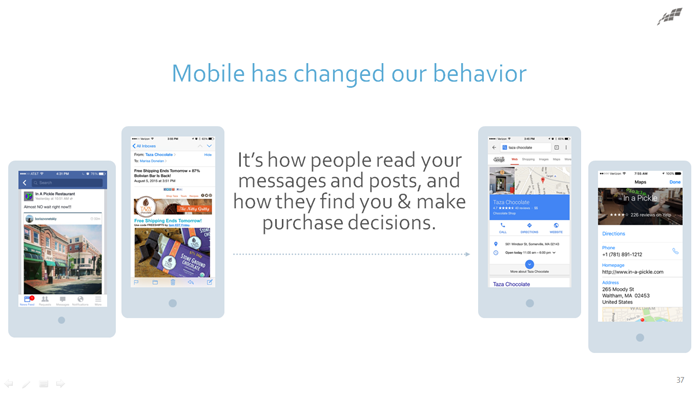
As mobile devices have become central to our daily lives, they have driven changes in our [click to build] behavior. Our phones have become core tools in how we research, find, compare and even purchase from businesses.
One term you will start to hear more and more in 2017 is “mobile-centric” search. This is defined as searches that happen 75% of the time or more from a mobile device.
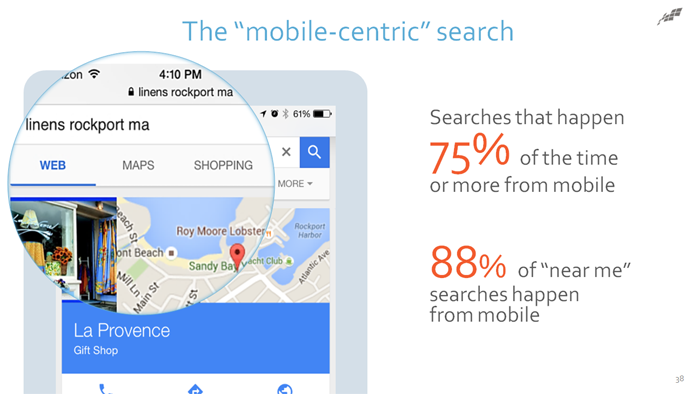
The reality is, people are using their smartphones to find something (everything) they need. In the example on the screen, a search for “linens” in Rockport, Massachusetts yields a top listing for La Provence, a Constant Contact customer. In seconds, a smartphone user can call the business with one touch, get directions they can use as a GPS in their car, visit the business’ website and view the contact information, such as its address and hours.
- For example, 88% of all “near me” searches happen from a mobile device, which is not surprising. Think about the last time you were out and about and needed to find a restaurant, or a dry cleaner, or even an oil change. With the accessibility mobile provides us, we find ourselves in a cultural trend of expecting to search for something exactly when we are ready to act on it.
88%…https://www.searchenginejournal.com/google-mobile-search-tips/159053/
75%…https://www.thinkwithgoogle.com/articles/build-your-mobile-centric-search-strategy.html
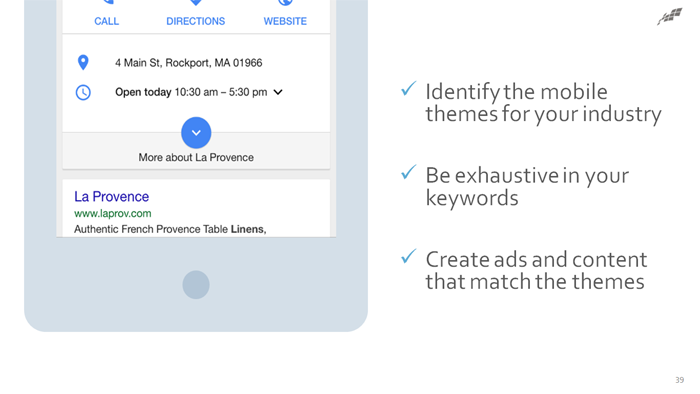
Identify the mobile-centric themes for your industry.
Some of the top industries for mobile-centric searches are automotive, jewelry, and hotels, to name a few. Remember, not every trend MUST apply to you and your organization. Look into mobile-centric search for your industry, and move forward with this trend if you find a need from your target audience.
Be exhaustive in your keywords
If mobile-centric search is something you choose to pursue in 2017, do everything you can to optimize your search keywords based on your industry theme. This will increase your chances of being found during mobile searches.
Create ads and content that match
Put yourself in consumers’ shoes for these mobile-centric moments. What situations is your audience in, and what are they trying to learn, do, find, or buy on their smartphone? Then ask yourself, “Does the content of my ads and the functionality of my mobile site help my customers in their moments of need?“ If not, you may need to adjust those assets. A simple and effective place to start is by optimizing your mobile email marketing strategy. source: https://www.thinkwithgoogle.com/articles/build-your-mobile-centric-search-strategy.html
Remember all that noise I mentioned earlier?
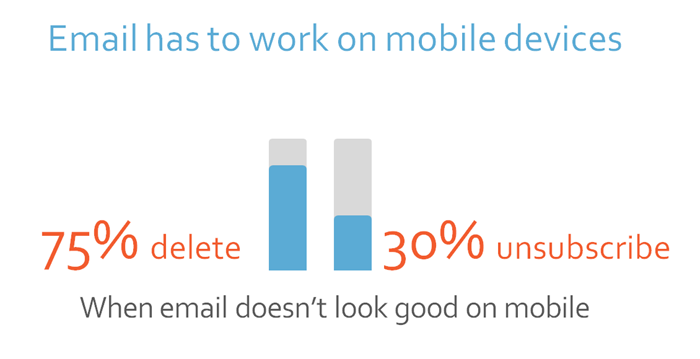
Well, consumers don’t need help throwing out those communications that are just part of the noise. If your email doesn’t look good on a mobile device (where most people are seeing it), 3 out of 4 of them will delete the email and never get to the message you were hoping to deliver, and almost a third of them will unsubscribe from your list…and never get any of your messages again.
Here are some of the most basic tips we can offer on how to ensure your email doesn’t end up getting deleted. Here are the 5 mistakes you most want to avoid:
1) TOO MUCH TEXT:
Don’t write too much!! Keep it short and sweet. We like to say “a picture, a paragraph and a call to action.” People don’t have the time or inclination to read through long emails on a mobile device.
2) MULTIPLE COLUMNS:
Multiple-column emails end up rendering in strange and unreliable ways on a mobile device. You run the risk of your content getting too messy for someone to easily read.
3) LARGE OFF SCREEN IMAGE SIZES
Make sure your images will work on smaller mobile screens.
4) TINY FONTS
Phone screens are small enough already…don’t make it any harder for someone to read your message…make your fonts sizes large enough for someone to comfortably read.
5) HIDDEN CALLS TO ACTION
The reason you sent the message in the first place was to get your readers to take some sort of action, right? Don’t make it hard for them to see what that action is, and to take it. Don’t bury your links in the middle of a paragraph or at the very bottom of a long email.
Those are five simple tips that will help you get your emails working on mobile devices. Check all of those things today. It’s worth the time!
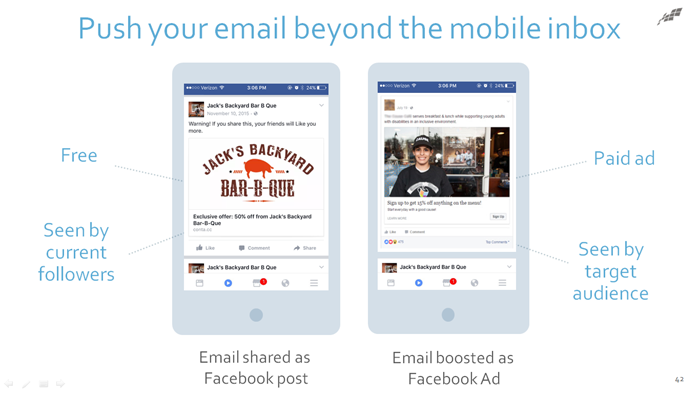
Once you’ve got your messages formatted to work effectively on a mobile device, now you can start leveraging the fact that people have their phones with them almost all of the time, and are using them to do things like read email and check social media. Why not cover both bases with one message?
There are two ways you can make your email more visible on social media (and therefore mobile devices), each of which have their own unique benefits, depending on your goal:
- Share an email to your profile, which will be viewed by your currently following. This is free and easy. And if you can nail the content that your audience finds valuable, this is a great way to encourage engagement and word of mouth referrals.
2. Or turn your email into a Facebook ad. This is also very easy to do, if you’re using Constant Contact. There is a cost associated, but you will benefit from an increased reach beyond your current followers. Facebook has become very adept at matching your target audience to potential new customers (donors, volunteers, clients, etc), so there’s a high chance for return on investment.
Have you ever seen an ad on social media? If you’ve ever purchased an ad from social media you’re ahead of the trend for 2017. Mobile advertising (especially on social media) is something you will probably hear about A LOT this year, if you haven’t already.
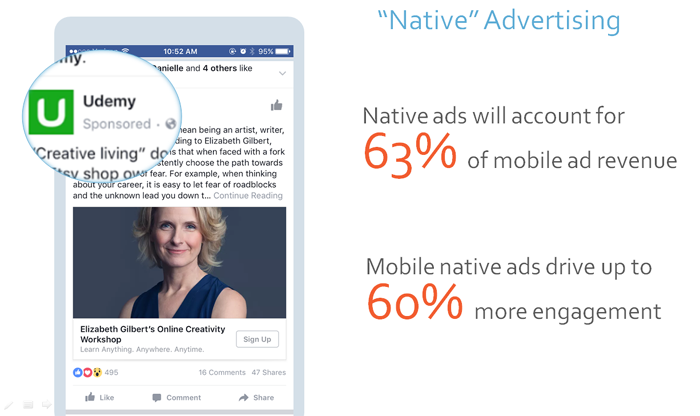
The other aspect of mobile that is maturing before our eyes is the ability to consider the mobile experience in advertising. A term you will hear more and more in 2017 (if you haven’t already), is “native ads”.
This refers to ads that blend in with the regular content on a given site, rather than standing out as a pop up or banner ad. You can barely tell the difference between a post in your feed versus a sponsored ad, which is exactly why it’s a worthy trend in marketing.
Estimates predict that native ads will account for 63% of mobile display ad revenue by 2020 for a variety of reasons. Social platforms, which many credit with popularizing ads in news feeds, are starting to draw a greater share of overall display ad spend. As mobile users continue to get more of their content on Facebook, Instagram, Snapchat, and Twitter, companies will continue to pour more ad dollars into these platforms.
And for good reason…Mobile native ads typically drive greater engagement levels than other types of mobile display ads. Clicks, shares, and other similar metrics on native ads are 20-60% greater than mobile banner ads, according to the estimates. Source: https://www.businessinsider.com/heres-why-native-ads-will-take-over-mobile-by-2020-2016-4
Here are some great examples of native ads.

Google and many of the popular social media channels have created opportunities for brands to advertise through their channels, including twitter and snapchat (not shown above). Yes, you have to pay, but as we’ve seen the organic reach of social media decreasing over time, it’s becoming more important to consider spending money to get in front of those prospects you want to reach.
What can you do today? Here are a few things:
– What is your mobile experience like? Are you being found? And if you are, does it look good on a mobile device?
– Consider purchasing ads that will show up on social media and mobile devices. Native ads are a smart bet.
– Are you a marketing consultants? You could consider wrapping a service around optimizing for mobile, helping your clients ensure their communications work on mobile devices.

You’ve jumped on the digital marketing bus, you carefully developed your content and segmented your audience, and you’ve ensured that your communications will work on a mobile device. So you send your campaign, and you wait for the results.
How will you know if you were successful? Does looking at the reports help or just confuse you? How do you know if something worked or didn’t? Or if something should be working more?
We’ve been inundated with talk of big data for years…and it’s true that data is all around us. The challenge is to avoid a common pitfall with all of that data the pitfall of drawing conclusions or making comparisons just because the data was available.
Now, this is a humorous look at what could happen if you connect data from unrelated activities.
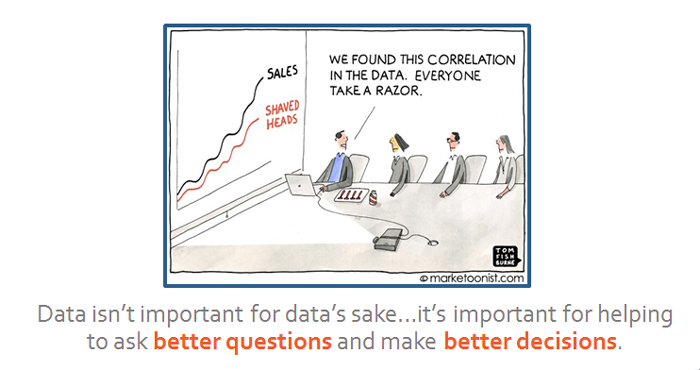
What’s important, though, is finding data that helps you ask better questions and then make better decisions.
Collecting data isn’t the hard part data is being created and collected all around us. In the demographic information that’s always being asked for, in point-of-sale transactions, event registrations and in all of the digital fingerprints that we leave in our wake, like opens, clicks, views, likes, shares, and comments.
The reality is that the more digital touch points you have with a consumer or prospect, the more data you receive on them. Some of this data arrives in real time.
Websites, email and social media are all tracking actions like opens, clicks, links referred to and from, intersections of known data with recognized behaviors, it’s all out there.
And it can be absolutely overwhelming.
So let me help you feel a little better.
I want to help you focus a bit in the face of all of that data.
I want you to think about what kinds of actions you ultimately want your customers or members or clients to take… [click to build]
These are just some of the actions that can be taken, right? But I’m sure you can narrow down the actions you want a customer to take more easily than you can sift through all of the possible data out there. Now I want to help you focus just a little bit more.
Why are any of these actions important? Are they important because you’re in the business of getting the most clicks possible, or fielding the most phone calls you can? No you want to generate revenue or donations. That is the point of your business or organization.
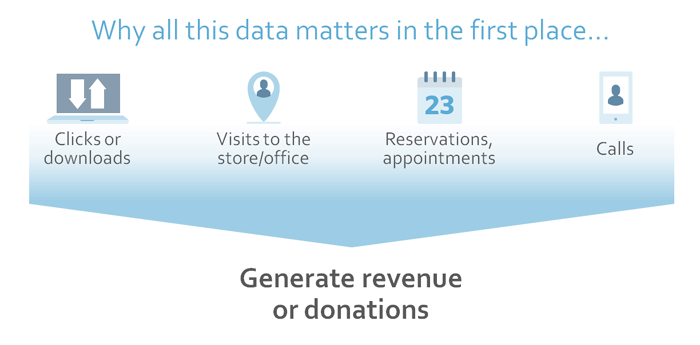
So, with that in mind, now you can start thinking about how you’ll approach the data you have access to. Let me take your through an example specific to email marketing data.
It’s easy to get caught up in the “low” metrics when determining whether or not we’ve achieved success. Let’s talk about what those metrics can tell us about our marketing.
What are some factors that might keep someone from opening your email? When you go through your inbox, how do you decide which emails to delete/ignore? Maybe you don’t recognize the sender. Maybe the subject line isn’t relevant to you and it doesn’t look time sensitive, so you think “I’ll come back to it later” (and of course, you never do). Maybe you just received a similar email very recently.
Based on those answers, how can we improve our open rate?
Brand recognition plays a large part in your open rate. The majority of people will not open an email from someone they don’t know. So make sure your from name is clearly recognizable and consistent with how your audience refers to your organization. You can also write your subject line in a way that creates urgency for your readers and entices them to see what’s inside. But keep it short; if it’s more than 5 to 8 words, it could get cut off by your recipients’ email services or smartphones. And finally, your timing and frequency could be off. We recommend starting with a monthly email and adapting from there. Too many emails, and your audience will ignore you or unsubscribe. Too few emails, and your audience might not remember signing up. Also consider, are you sending at the times and days that people would be most likely to read your email? Try a different day or time and compare your results.
You’re using these reports to get to know your audience better, so keep track of what’s getting the most attention in your emails. Segment your audience into different lists, and target them with relevant content based on what you know is working!
What are some factors that might keep someone from clicking on a link? When you read your email, what are some reasons you don’t click on anything? Maybe your link was not obvious, or it was hidden between articles or at the bottom of your message. Maybe there were so many links, your audience got overwhelmed and didn’t know where to click. Maybe it simply wasn’t interesting to those particular people.
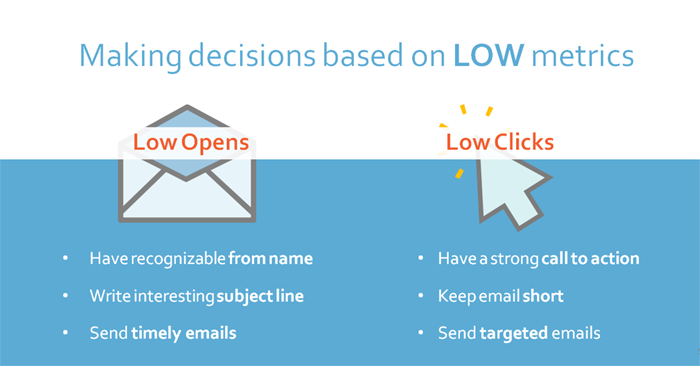
Based on those answers, how can we improve click through rates? What can we do to bring this number up?
Review the calls to action in your email. Consider the wording– is it clear? Is it urgent? Is it telling people exactly what action to take and why it matters to them? Look at your email design and consider how much content is in your email. If your email is too long, many people will give up and delete it before taking an action. Our recommendation is to have no more than 3 articles in an email. And keep those articles short! Include a sentence or two and then a link to read more. When you give people too many choices, they’re not sure what they should click on, and might not click on anything.
Let’s move on to the high metrics.
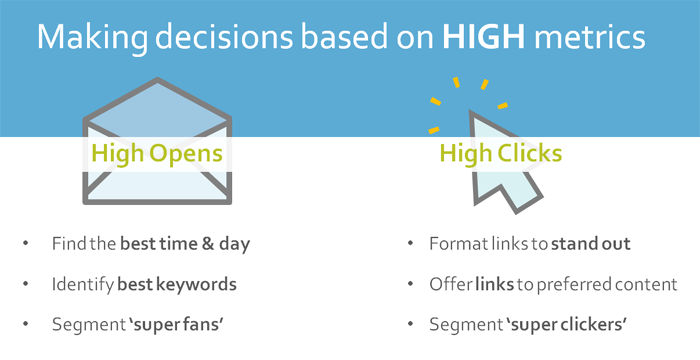
If you are getting great results, it’s easy to become complacent with your marketing. But that data is a personalized assessment of the things that work well for your audience, and therefore a great guide to the things you should keep doing and even improve.
The first is to find out what’s the best time and day to send your emails. When you look at your open rate report, you’ll see what date and time each of your readers opened your email. Start comparing that to the day and time you send your email – you should send your messages at the day and time your readers are opening them. They’ll be more likely to check their email then and see your message.
Next, take a look at your subject line – what keywords do you think were interesting to your audience? Think about the keywords you’ve used in your subject lines, in blog posts, on social media, and in your website that draw your audience’s attention. Keep using them in your subject lines.
Segment “super fans”.
The majority of email opens come from a very small group of readers. Usually, the same group of people will be opening your emails, with slight variations every time. This is an argument for smart segmentation – don’t simple send everything to everyone, but recognize that there is a core set of “superfans” who contribute the lion’s share of your opens. You should consider sending the most valuable emails to them first as an exclusive ‘sneak preview’ – make them feel special.
A high click rate is fantastic. Your audience wants to know more about the resources you’re linking to in your email. Here’s a few things you can do to make your click rate even better.
Format your links so they stand out when your readers open your email. Use buttons or put white space around them. Make sure the links are spaced out for mobile readers – if they’re too close, it’s really easy to click on the wrong link with your finger.
You’re using these reports to get to know your audience better, so keep track of what’s getting the most attention in your emails. Narrow down the links you offer to fit the topics, products and services that they want to read about.
The last thing you can do is take that knowledge of your audience and segment them. Just like you have “super fans” for opens, you have “super clickers”. These are readers who consistently engage with your messages. This is a huge opportunity to put a special offer in front of your “super clickers”, either by sending it to them ahead of the pack, or by selectively sending them something that is just for the most loyal consumers. By capitalizing on the reporting provided by Constant Contact, you have the ability via smart segmentation to do this for your consumers.
With that in mind, I’ve got three final tips on using data, and then I’ll wrap up.
1. Like the open rate that I just mentioned, beware of those “vanity stats” that might look good but don’t tell you very much. Always look deeper to find the connections of the data to actions that drive towards your actual business goals.
2. Start small…you don’t have to develop a full-blown approach to wrapping your arms around all of your data. Pick one or two tactics that you want to observe and track…focus on it and figure out how changes to your approach impact that aspect of your business. Once you feel that you have that one figured out, choose a different set of numbers that reflect another important part of your business, and so on.
3.Finally…and this is to make sure you keep it simple: DO MORE OF WHAT WORKS!! Sometimes the numbers may confuse the issue, no matter how much you try to justify them or find connections. If you seen something working, keep doing it. Pull other levers around that tactic and see what happens.
Here’s what you can do today.

- Determine what #’s really matter for your business. What numbers will reflect the actions that drive business results.
- Don’t just look at a snapshot…look at those numbers over a long period of time (12 months)…determine what the cycles or seasons are for your business are and how you might think differently about your efforts around those cycles.
- Finally, based on those important numbers and their performance over time, choose just one thing in your approach to start adjusting. Start small…and track those results.
That’s a lot of information…but I hope it’s all been helpful. You can find a lot of other trends out there, but these are some of the most important ones to be considering for your business.
Let me quickly recap.

- Marketing automation
- Content marketing
- Video marketing
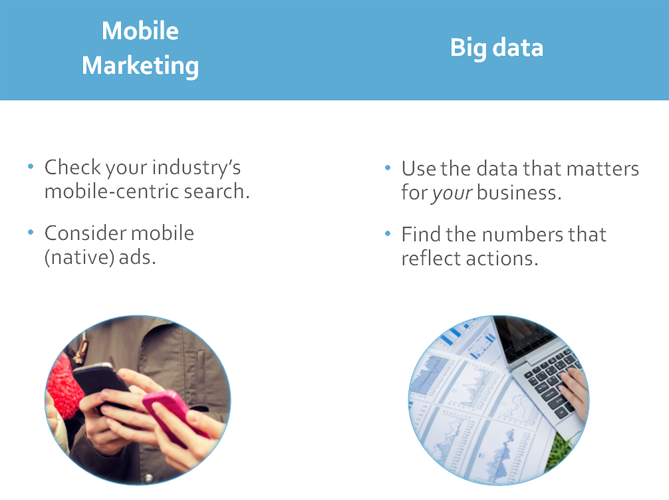 – Mobile Marketing
– Mobile Marketing
– Big data
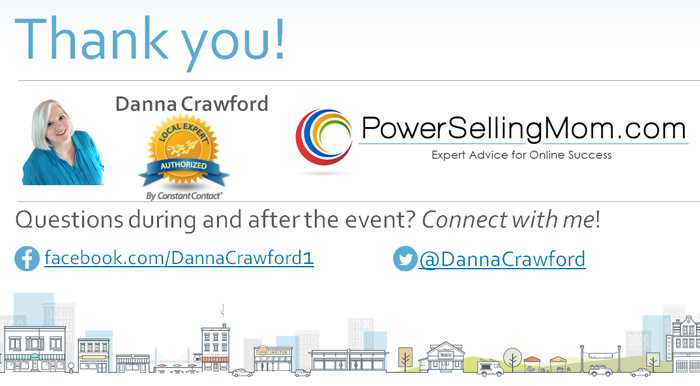
WEBINAR VIDEO REPLAY:


Thank you!
it is a good fantastic list.